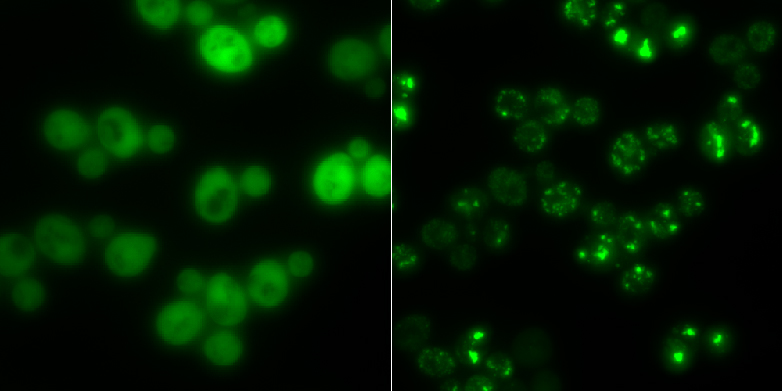Clumps as temporary storage
Researchers at ETH have discovered that the formation of protein aggregates in yeast cells is reversible. This casts new light on human diseases that can be attributed to certain protein aggregates.
Protein aggregates have a bad reputation. A number of human diseases, especially those of the nervous system, such as Alzheimer’s, Parkinson’s, or amyotrophic lateral sclerosis (ALS), are due to the clumping of degenerate proteins in nerve cells, creating aggregates that the cells cannot dissolve. This causes the cells to die.
Now, researchers led by ETH Professor Matthias Peter and Reinhard Dechant have shed new light on protein aggregates in a study involving yeast cells. The corresponding paper has just been published in the journal Nature Cell Biology. In it, the ETH scientists show that protein clumps form in yeast cells in response to stress factors such as nutrient starvation or heat. If the cells survive the stress, they can dissolve the aggregates again, quickly recycle the individual components, and use them for cellular metabolism.
Clumps form in response to stress
The researchers’ discovery of the enzyme Cdc19 is an example of a protein that clumps together under stress. The enzyme supplies energy to the cells. The researchers discovered that Cdc19 breaks down into four identical subunits upon glucose starvation. These subunits then change their original shape and clump together with other molecules, such as ribonucleic acids or other enzymes, to form aggregates. The researchers refer to these clumps as stress granules. Once incorporated into an aggregate of this kind, Cdc19 becomes inactive and is no longer able to produce fuel for the cell. During this time, the cell can neither grow nor multiply.
However, the process is reversible. As soon as the stress has passed, the stress granules dissolve, and the four subunits of Cdc19 assemble together so that the enzyme can resume its role in glucose metabolism.
The clumps have a clear purpose, says Matthias Peter: “The yeast cell uses aggregates as a sort of warehouse for important enzymes, so that these are protected from breakdown in stress situations and can be reactivated immediately after the cell survives the stress.” The aggregates, he says, protect these molecules from being broken down by the cell’s own disposal mechanisms. If the cell had to synthesise these compounds again after each stress situation, it would cost the cell a lot of time and energy.
A simple sequence is sufficient for clumping
The researchers also clarified how and why Cdc19 is able to form clumps. In the structure of a Cdc19 subunit, they identified a short, unfolded subsection with a simple composition. In technical terms, these sections are known as “low complexity regions” (LCRs), and the researchers say they also occur in other aggregate-forming proteins in other organisms, including humans.
“The LCRs are exposed due to the breakdown of the enzyme complex and trigger the aggregation process,” says Peter. “It was therefore important for us to find a sequence of this kind in Cdc19. This confirms that there is a general mechanism.” In the yeast’s normal state, the LCR of Cdc19 is concealed, or has several phosphate groups that the LCR “deactivates”. It is only in the event of nutrient stress that the LCR emerges and the phosphate groups are removed – and only then can aggregates form.
An important finding
“Our research has created a sense of a new awakening in the scientific community,” says Reinhard Dechant, a group leader at the Institute of Biochemistry, who led the study together with Matthias Peter. Until now, he says, aggregates were primarily seen as pathogenic particles, because the only thing visible in patients is the result of the process – that is, insoluble protein plaques that cause a disease. “Our paper also examines the start of aggregation and how it progresses,” says Dechant, explaining that protein clumps will not form simply because of a disease, but rather because the cell needs them in order to survive a stress situation. “For the first time, we were able to show that both the formation and the breakdown of aggregates is an important mechanism in cells.”
Other ETH Zurich research groups examining aggregates in yeast cells have made similar discoveries in the past. Accordingly, other ETH scientists were able to demonstrate that clumps of degenerate proteins work, among other things, like a memory and help the cells to store past (negative) experiences (as reported in ETH News). It therefore appears that the functional aggregation of certain proteins is a widespread regulatory mechanism.
Reference
Saad S, Cereghetti G, Feng Y, Picotti P, Peter M, Dechant R. Reversible protein aggregation is a protective mechanism to ensure cell cycle restart after stress. Nat Cell Biol. 2017 Oct;19(10):1202-1213. doi: external page10.1038/ncb3600call_made. Epub 2017 Aug 28.

